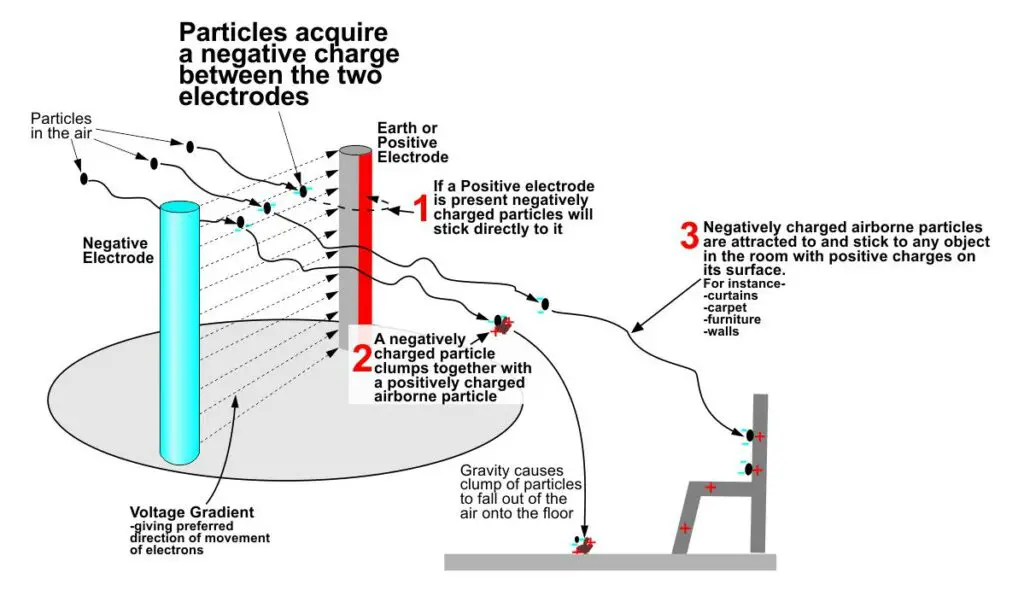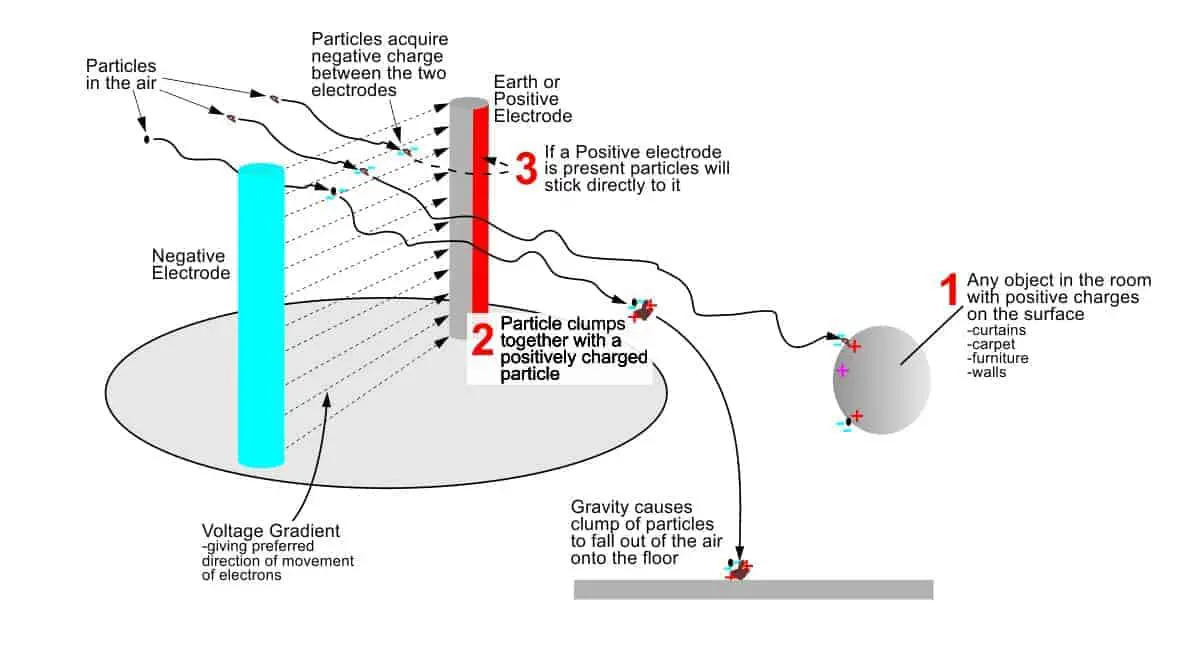Air purifiers remove particles and chemicals from the air. So, what is a negative ion air purifier and how does it work?
A negative ion air purifier is one that causes particles in the air to gain a negative charge, which makes them bind together with positively charged particles and fall out of the air or stick to positively charged objects in the room. They are not as effective as air purifiers based on HEPA filter technology.
There are 2 types of ionizers-
- Negative Ion generator (air ionizer)-a high voltage is used to ionize and add an electric charge to air molecules
- Electrostatic discharge ionizer (balanced ion generator)-used to neutralize static charge
But you might also wonder how they work, how safe they are, and also how effective they will be at cleaning your indoor air compared to just a standard air purifier. So, read on to discover the answers to these questions and more.
How does a negative ion air purifier work?
An ionizing or negative ion air purifier is a device that creates a negative charge on particles that can then stick to the positive electrode, to each other and fall to the ground, or stick to positively charged objects eg walls or curtains. Once the particles are attached to another object or are on the floor, they have effectively been taken out of the air.
It works by using a high-voltage electric field to attach negative charge to first molecules such as oxygen to give O- + O or O2-. These can then further interact with CO2->CO3- and with H2O->OH-. These negatively charged ions can react with particles so that they gain an overall negative charge. This can apply to airborne pollutants such as dust particles, allergens, pet dander and mold spores.
This method of removing particles is particularly suited to ultrafine particles.
The mechanism of how an ionizer air purifier works is shown in this diagram-

In some filters, usually in HVAC systems, there are positively charged plates to which these negatively charged particles are attracted and then deposited on the plates. As the plates become completely coated with negatively charged particles, they lose their effectiveness as there are no longer exposed areas with positive charge. So the positively charged plates must be cleaned periodically.
Negative Ion Generators Are Not As Effective as HEPA Air Purifiers
Coarse and Fine Particle Removal
Negative air ion generators can significantly reduce dust particles in the air by “several percent“. This is in contrast to HEPA air purifiers which the EPA suggest should be sized to the room to reduce particle count by a minimum of 80%. Whereas the same study showed that with electrodes hung from the ceiling throughout the room, the particle count could be reduced 100 fold. So there is little doubt that a very high concentration of negative ions in the air can very effectively reduce the number of particles in the air. How safe this would be is open to debate-please see health effects below.
At lower concentrations, no consistent effects have been found on health.
Ultrafine Particle Removal
Ultra-fine particles (less than 0.1um diameter) can get particularly get deep down into our lungs and even enter our bloodstream and be deposited in our brains. Negative ion air purifiers are particularly effective at removing these ultra-fine particles from the air. The experiments performed in this study demonstrated this, but they are only effective in the area surrounding the ionizer.
There is also one “Hyper-HEPA” filter on the market that is specified to remove ultrafine particles-99.5% of particles greater than 0.003 um. So this filter effectively removes all ultrafine particles. So there is no additional benefit from having an ionizer.
Inhibition of Micro-Organisms
Studies have shown that high concentrations of negative ions in the air bacterial growth and fungal growth can be inhibited, although other studies have suggested little or no effect. Negative ions by precipitating fungal spores out of the air do seem to reduce infection, but this is not a direct effect on fungal growth.
Other Disadvantages of Ionizers
Need to be Near the Unit to be in Clean Air
In general, they are not as effective as a HEPA filter because the particle count increases with distance from the unit quite quickly. To increase their effectiveness, ionizers can have fans to increase the reach of their purification. Indeed Consumer Reports does not think that an ionic air cleaner without a fan is an adequate alternative to a HEPA air purifier. Even with a fan it is quite possible that the clean air delivery rate would not be high enough for your room.
Increased Maintenance of the Purifier Compared to a HEPA Air Purifier
The electrode in the negative ion generator will need occasional cleaning. This includes electronic HVAC filters as mentioned above.
Increased Home Cleaning Compared to a HEPA Air Purifier
Positively charged objects can simply be materials or objects in the room that have an electrostatic charge such as carpets, curtains or upholstery. So the particles remain in the room spread over many surfaces. The removal of particles is influenced by the surfaces in the room-with wooden walls there is a greater fall in particle count than with wallpaper. All these surfaces will need cleaning as otherwise when the particles are disturbed they will be sent into the air again.
A HEPA filter simply collects them in the filter and when the filter is replaced the particles are thrown out with the old filter. If anything less cleaning needs to be done.
No Effect on Chemicals
Ionic air purifiers do not remove chemicals from the air as activated carbon filters do. Their ionization cannot affect gas molecules, so they are not good for removing gaseous pollutants. Most HEPA filter air purifiers have at least the option of the carbon filter to remove chemicals.
Ozone Production is a Potential Problem.
Ozone above a certain level can be hazardous to human health as it irritates the airways in our lungs. All Ionizers produce ozone, but this can be in amounts that are not known to be harmful. The California Air Resources Board lists ionizers meeting their indoor ozone limit of 0.05 parts per million.
Are negative ion air purifiers safe?
As a general rule negative ion air purifiers either produce a modest amount of ions and are safe but not very effective or they produce lots of ions and are effective but may not be very safe. The consumer machines tend to produce modest amounts of ions. Two studies showed that ionized air has no negative health effects on humans, animals, and plants. Another analysis of many studies that have been done found no effect on the human respiratory system, but neither did it find any beneficial effects. There has been a recent study documenting increased oxidative stress in young healthy adults exposed to fairly intensive negative ion air. Oxidative stress is thought to be one of the mechanisms of aging, so high doses of ions may speed up aging.
In a classroom study from China concerning 44 children the number of ions in the air was increased a thousandfold. PM 2.5 was reduced 44% and ozone levels were unchanged. There was a 4% percent increase in the amount of air the children could breathe out in a second and a 15% decrease in their exhalation of nitrogen oxide – a marker of airways information. However there were signs of a negative effect on the heart, in that heart rate variability was decreased. So it seems that high concentrations of ions have concerning effects on the body.
Just as charged particles can deposit on the walls of the room they can also deposit in our airways. In fact electrostatic charge on particles greatly enhances their deposition in human airways. However this is only a significant factor if the particles have multiple ionic charges.
A recent study showed that an ionizing device led to an increase in some volatile organic compounds (VOCs). These tended to be alcohol or aldehydes and included toluene. These are the type of chemicals in paint, pesticides and hairspray. Other VOCs were reduced. There was little effect on PM 2.5 particle counts.
So these studies do raise concerns about how safe ionizing air purifiers are, if the number of ions raised enough to provide a reduction in particle count. Note that even when the number of ions was increased by a factor of a thousand the PM 2.5 particle count was any reduced 44%. This is approximately half the particle reduction that we would expect by using a HEPA air purifier with good technique.
Static Electricity
Persistently pumping negative ions into an enclosed space will naturally lead to buildup of charge on surfaces in the room. This causes “static electricity” which could potentially damage electrical equipment quite apart from being unpleasant for people in the room.
Do Not Confuse Negative Ion Generation With the Following Methods of Air Purification
- Plasma air cleaners use high voltage discharge to ionize and break apart molecules of gases.The disadvantage is that these can act as an ozone generator. Ozone is known to be harmful to the airways in the lungs. They can also produce harmful byproducts such as formaldehyde and carbon monoxide.
- Photochemical electro chemical oxidation uses electricity and electrodes to destroy particles and so works in a different way. An example is the MoleKule Air purifier, which was labelled one of the worst air purifiers of 2020 by Consumer Reports and also in 2020 “the worst air purifier we have ever tested” by Wirecutter for the New York Times.
- Photochemical Oxidation-Uses a high-surface-area catalyst such as titanium dioxide to absorb gases. When the catalyst is irradiated with UV light, hydroxyl irons are produced, which then oxidize the gases absorbed onto the photo catalyst.A problem with this approach is that harmful substances such as acetaldehyde, formaldehyde, nitrogen dioxide and carbon monoxide can be produced. This type of air cleaner can also generate ozone if the UV light does not have a coating to prevent ozone production.
Conclusion
There are several disadvantages with having a negative ion air purifier which only has an ionizing unit and no filter. If you did buy one would need to check, as the EPA suggests, that it’s clean air delivery rate (CADR) is adequate for your room. You are very unlikely to find an ionic air purifier suitable. Also, they are not recommended by the EPA, Consumer Reports or Wirecutter, which should make you think twice before buying one as your only air purifier in a room.
You would need to buy a good air quality meter to make sure that at the point of the room where you are breathing the air, the air purifier delivers at least an 80% reduction in particle count.
The principal reason for buying an air purifier with an ionizer would seem to be if you are not sure that the true HEPA filter in your air purifier can cope with ultrafine particles. This logic would also apply to an HVAC system where often there is considerable doubt as to the ability of the filter to catch ultra-fine particles (please see this post).
There are some doubts about whether negative ions could have adverse health effects. There is one study suggesting that negative ions increase oxidative stress in the body and could speed up aging.
The best solution to this is to buy an air purifier which has a HEPA filter specified to remove ultrafine particles-the Hyper-HEPA filter (in air purifiers in the iQair Healthpro range) or the Oransi EJ120 air purifier.

